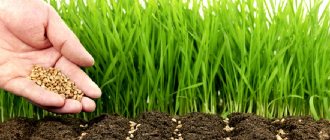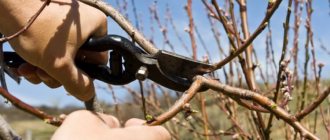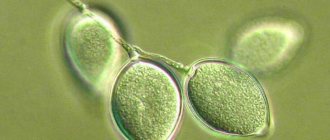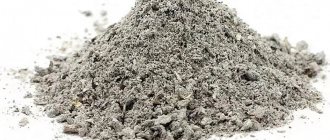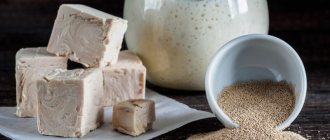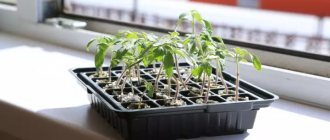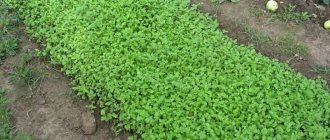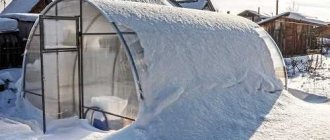Preparing for winter
It is no secret that the soil of any greenhouse is depleted throughout the year, and harmful insects and diseases actively multiply in the top layer.
The soil should be changed every 5 years. And throughout this period, the land needs annual cultivation. Autumn disinfection of a greenhouse helps solve many problems, the main ones of which are:
- eliminating sources of disease;
- destruction of eggs and larvae of many pests;
- increased fertility;
- soil remediation.
The top (fertile) layer of soil is removed with a shovel. Then the soil is dug up, removing the pest larvae. An excellent method of combating soil depletion and the proliferation of harmful insects is sowing green manure. They can be legumes or cereals, mustard. Shortly before the onset of cold weather, the greens are mowed and the soil is dug up. Some gardeners embed the green mass into the soil, others do not.
If new soil has been brought in, it should be treated with chemicals or biological products before spreading.
What fertilizers to apply in the fall for digging?
The worst place to “fill” the soil with useful substances is for those who have predominantly clay and loamy soils on their site. During the winter they become so dense that almost nothing grows in them. Such soils need to be loosened in the fall and then one or more fertilizers must be applied:
- manure - apply about 3-4 kg per 1 sq.m. no more than once every 3-4 years. After digging the soil to a depth of 15-20 cm, carefully lay it around the plants, but make sure that the composition does not come into contact with their root system - otherwise it may burn;
- grass cuttings, i.e. finely chopped weeds and grass. First, form a furrow 20 cm deep. Place a 5-7 cm layer of prepared weeds or tops remaining after harvesting on the bottom, and cover with a layer of soil on top. Then add another layer of chopped grass and cover with soil again;
- phosphorus-potassium fertilizers. On average, apply 40-60 g of superphosphate and 25-30 g of potassium salt or potassium sulfate per 1 sq.m of soil;
- green manure. There is simply no better time to plant green manure into the soil than autumn. Once they reach a height of 10 cm, they can be cut and dug up with soil.
Overwintering plants mainly need phosphorus and potassium and, to a lesser extent, nitrogen.
What fertilizers to apply in the fall for digging?
In the fall, most of the crops have already been harvested and there is an opportunity to take a break from working in the garden. However, before completely finishing work in the garden and vegetable garden, it is necessary to apply the necessary fertilizers and dig up the soil. When the soil rests, the microorganisms in it can process nutrients much better.
Disinfection of soil in a greenhouse in autumn
Steaming is considered the most effective way to treat soil in a greenhouse in the fall, which allows you to get rid of hidden infections and destroy pathogenic bacteria and microorganisms. The beds are poured with boiling water, covered with a thick, opaque film, pressed on the sides with a weight to create a greenhouse effect inside, and left for a day. Then they loosen, carefully select the remaining roots, and repeat the steaming procedure 2 more times.
The photo shows an example of how to properly steam
To destroy the larvae and eggs of harmful insects and tenacious infections, it is recommended to carry out chemical treatment after steaming. One way to disinfect the soil in a greenhouse is to abundantly water the beds with a manganese solution. To enhance the effect, sprinkle the ground with bleach at a rate of 100 g/m2, dig it to the depth of a shovel, and loosen it so that the substance gets into the deep layers.
In the photo, preparing Bordeaux mixture with your own hands
The next step in how to improve the soil in a greenhouse is to treat it with biological preparations that not only destroy infections, but also significantly improve the structure of the soil, enrich it, stimulate air exchange, bind metals, and actively help decompose organic matter. The most popular biological products for soil disinfection in a greenhouse:
After intensive disinfection, it is necessary to prepare the soil for the winter in the greenhouse; its structure should be fed and improved. It is recommended to sprinkle cleaned and disinfected beds with ash, river sand, scatter sawdust, peat, compost, if the soil is depleted, apply fertilizers, the choice of which depends on what crop will be sown in the greenhouse. Dig up, harrow.
Pests and diseases
Most diseases prevalent in greenhouses are caused by fungal spores.
Late blight
It affects peppers, tomatoes and eggplants. The disease is expressed in the appearance of dark spots on nightshade leaves. If immediate control is started, the harvest can be saved. Plants are treated with copper sulfate (a couple of times), copper chloride (stop using 3 weeks before harvest), arylin or Bordeaux mixture (every 12 days).
Powdery mildew
It manifests itself in the formation of white spots, first on the inside of the leaves, and then on the entire plant. A characteristic disease of late summer and early autumn, with sharp temperature fluctuations and heavy rainfall. Leads to the death of plant tissue. For powdery mildew, fungicides are used, copper sulfate in combination with ordinary laundry soap.
Cladosporiosis
Characterized by rapid spread. It manifests itself in the formation of brown spots, as well as further falling of leaves. Pseudobacterin, Polyram (these drugs are used several times), Hom (one treatment with this strong remedy is enough) are used against the disease.
Fusarium
An infectious disease that first affects the rhizomes and then spreads to the stems. The foliage changes color from green to pale yellow and quickly fades. Dangerous in autumn. Trichodermin and Benazol are used as control agents.
Whitefly
The leaves affected by it become deformed and dry out, and dark spots appear on the plants themselves, and the buds quickly fall off. The following drugs will help in the fight against this pest: Mospilan (one treatment is enough), Verticellin, Actellik.
Spider mite
The foliage dries out and turns brown. A thin web appears on the plants. If the pest is not controlled, you can lose most of the crop. Effective drugs: Fitoverm (several treatments), colloidal sulfur (use once every 2 weeks), Bitoxibaccellin (every 14 days).
We suggest you read: How to prepare rose hips for the winter
These pests are dangerous because they suck all the juices out of plants. Greenhouse crops begin to become covered with a sticky coating, wither, and dry out. Actofit, Karbafos and some highly toxic drugs are effective against aphids.
Ants
They harm plants both on the site and in the greenhouse, and throughout the warm period. You can fight them both with folk remedies (wormwood, garlic, bay leaf, mint) and with store-bought drugs (Aardeater, Thunder).
How to treat the soil in a greenhouse in the fall
You can often observe mold in a greenhouse on the soil. The earth has turned green, the reason for this is fungal infections due to high humidity, poor ventilation and insufficient drainage. To get rid of the disease and prevent it from spreading deeper, you need to:
- remove the affected layer of soil;
- fertilize the soil with crushed sphagnum and wood ash;
- pour in nutritious soil mixture, which you can buy in a store or prepare yourself;
- dig to the depth of a shovel, loosen;
- pour in a solution of foundationazole, 2 g of the drug per 1 liter of water;
- carry out mulching, in the fall it is better to do this with green manure, for example, plant mustard - this is the most favorable crop for closed ground.
Mulching can be done with sawdust
Autumn is the optimal time to deoxidize the soil in a greenhouse. Acidity can be determined using traditional methods. Several leaves of black currant (bird cherry) are brewed in 200 ml of boiling water, cooled, and a lump of soil is dipped into the broth. The water has become reddish in color, which means that the soil in the greenhouse is acidic; if it is slightly green, the soil is slightly acidic, and if the broth has acquired a bluish tint, then it is neutral.
There are several ways to disinfect the soil in a greenhouse in the fall from excess acidity:
- Quicklime (CO) or slaked lime (fluff), the substance is scattered over the beds and loosened the soil.
- Limestone flour, which contains calcium and sodium carbonate. For deoxidation, it is advisable to use fine grinding.
- Dolomite limestone in flour, the substance is considered the best substance in the fight against acidity.
To eliminate minor acidification, you can use crushed chalk or marl.
Try to mix the soil so that the lime gets deep into the soil
What fertilizers are applied to fruit trees in the fall?
The period for applying fertilizers to fruit trees is mid-October. It is the autumn application of fertilizers that best helps trees survive cold winters. In autumn, the following fertilizers are applied to fruit trees:
- humus improves the structure of the soil, directly affects productivity, providing the tree with all the necessary substances. For young trees, 30 kg of humus should be applied, and for those that are 9-10 years old or more - up to 50 kg;
- phosphorus-potassium fertilizers. For each apple and pear tree, apply 300 g of superphosphate and 200 g of potassium sulfate. Fertilizers are embedded together with organic matter or poured into a circle near the trunk and watered with water. For plums and cherries, the preparations need to be diluted in a proportion of 3 tbsp. superphosphate per 10 liters of water and 2 tbsp. potassium sulfate per 10 liters of water. Pour 4-5 buckets of the resulting solution under each mature tree;
- complex fertilizers, such as “Orchard”, “Universal”, “Autumn”. They should be applied in accordance with the instructions on the package;
- manure is also often included in the autumn “menu” for feeding trees. But remember that you cannot fertilize trees with fresh manure; it must “reach” readiness in at least 2-3 years. They bring it into the trunk circle when digging, and then mulch the soil with mowed grass or another type of mulch. The application rate for fruit trees is 4-5 kg.
After fertilizing, it is advisable to mulch the trees.
Install supports
If with film greenhouses everything is simple, and for the winter the covering material is removed from them and stored separately, then with polycarbonate there are nuances. It makes no sense to remove it every year, but leaving it on the roof is dangerous - it can break under a layer of snow.
To prevent this from happening, you need to either regularly clear the snow from the greenhouse or install supports inside. The first option is more difficult, but more effective - coming to the garden after every heavy snowfall and cleaning everything off is not easy, but this way you will definitely protect the greenhouse from damage. If this is not possible, put together structures that look like giant mops or the letter T and install them so that a piece of polycarbonate on the roof slope rests on a horizontal crossbar.
Preparing your greenhouse for winter may take you a whole weekend, but you can't skip it. In addition, all work takes place in the autumn period after harvesting, when there is less and less work on the site. Believe me, this time will not be wasted, and in the spring you will be able to plant greens and seedlings in a clean and safe greenhouse with a clear conscience.
- 5 interesting ideas on how to build a winter greenhouse with your own hands
Options for unusual winter greenhouses.
We suggest you familiarize yourself with: The best varieties of cucumber seeds for a greenhouse
Tags: earth, winter, greenhouse, fertilize
About the author: admin4ik
« Previous entry
Treatment and disinfection
Unfortunately, it is rare to find humus without mole crickets, so it is better to immediately get rid of this pest by spreading the treated seeds in the greenhouse a couple of days before the dive.
If the same crops are grown in a greenhouse, for example tomatoes, most likely various pests of these particular vegetables have already appeared in the soil. Therefore, before planting seedlings, it is worth spilling the soil with a hot (about 60 ° C) solution of potassium permanganate at the rate of 1 gram per 10 liters of water.
It is necessary to disinfect not only the soil, but also the greenhouse itself. To do this, all wooden structures are washed with copper sulfate, which destroys fungi, lichens and moss, and after a week they are coated with bleach.
To obtain the treatment agent, 400 grams of bleach are infused in 12 liters of water for 2-4 hours. Then the liquid is drained and the sediment is used for coating. If in the summer the greenhouse plants suffered any disease (for example, tomatoes suffered from brown spot), greenhouse structures and glass should additionally be sprayed with foundationazole or oxychome.
You can read more about disinfection in the article: disinfection of greenhouses and greenhouses.
Autumn treatment of a greenhouse involves both disinfection of internal structures and disinfection of the soil. During the warm period, the soil becomes overgrown with fungal spores and harmful bacteria. Therefore, pre-winter treatment of a greenhouse includes not only replacing the fertile soil layer, but also a number of measures to combat diseases and pests.
Disinfection of a greenhouse is carried out in several ways:
- by treatment with various chemicals;
- by steaming the soil;
- biodisinfection method.
The most popular chemical compositions among gardeners are:
- formalin (dosage 1:100);
- based on potassium permanganate (1 small spoon per 1000 ml of water);
- bleach solution (0.4 kg per bucket of water);
- copper sulfate (1 large spoon is enough for a bucket of water).
Use any of these solutions to thoroughly water the soil in the greenhouse.
Chemical methods of soil disinfection include fumigation with sulfur bombs, which are popular among gardeners.
Soil steaming is a thermal disinfection method. Usually the soil is simply poured with boiling water and covered for a couple of days. This procedure is repeated at least 3 times. Boiling water kills pathogenic soil microflora.
We invite you to read: Features of growing water mint
Biological preparations for soil disinfection in greenhouses also deserve attention. They are safe not only for humans, but also for fruit crops. In addition, they have a wide range of positive effects on the earth. Among the popular biological products are Trichodermin (half a glass per bucket of water), Fitosporin (7 ml per bucket), Alirin (one tablet is enough for dilution in 10 liters of water).
Copper sulfate
One of the most effective ways to combat late blight, cladosporiosis and other soil diseases. In addition, the substance supplies the soil with an essential trace element (copper), acts as a powerful antiseptic, destroys pests, and fights rot and fungus.
It is enough to take 100 g of a chemical product per bucket of water. Some gardeners add a little slaked lime to the solution. They are used to treat the soil in the greenhouse. It is recommended to do this procedure no more than once every 5 years. If you add a little grated laundry soap to the composition, you will get an excellent product for treating greenhouses from the inside.
Sulfur checker
This product is very popular among people due to its availability and excellent effect. After all, acrid smoke easily penetrates into all corners of the greenhouse. Diseases and pests have no chance to escape.
The number of sulfur tablets is determined by the size of the greenhouse. Standard consumption – 2 pcs. for 10 sq. m. Each tablet comes with a special wick.
The checkers are distributed over the entire area of the greenhouse, all windows and doors are closed. You can enter the greenhouse only 3 days after fumigation. It is better to wash the inner walls of the greenhouse with soapy water.
Other options
The soil in a greenhouse can be disinfected:
- bleach. It is enough to simply add dry matter in the fall. The walls of the greenhouse are treated with a lime solution;
- by completely replacing the soil;
- highly concentrated preparation Carbation.
Per cubic meter of area you will need 400 g of the drug diluted in a bucket of water. The soil temperature during processing should be from 9 to 17.
What kind of soil do tomatoes need?
Autumn work at the dacha does not end with harvesting and garbage collection. There are a lot of worries in the garden in the fall, and one of the important ones is preparing the greenhouse for the next season. Tell me why? This is a kind of investment for a future rich harvest.
Preparing a greenhouse for spring is not only about digging up the soil, or rather, this is the last stage of preparation.
First, it is necessary to carry out a series of works to cleanse it of insect parasites, fungi, pests and infections that have settled not only in the ground, but on the structure itself, in cracks, on the coating, on lintels and at joints.
First, we do some general cleaning, and then we clean up the house for the future harvest.
First of all, we remove all the tools, watering cans, hoes, supports supporting the plants, and more.
Completely remove all plant waste from the structure, as it can harbor harmful bacteria.
We wash the entire structure from the inside, including the covering, joints, lintels, and ceiling.
Do all these simple steps carefully, and in the spring it is worth repeating the treatment of the walls and ceiling of the greenhouse again to be sure of the destruction of disease spores and infections.
Do not put off this matter until the cold weather; it is better to cultivate the land at an air temperature of at least 10 degrees.
General preventive measures consist of several important points.
Hot method. Eco-friendly, but more labor-intensive.
To disinfect beds in a greenhouse, they are thoroughly poured with boiling water, after which they should be covered with thick black film or roofing felt and pressed down with weights so that the steam is retained in the soil for as long as possible. After a day, the film is removed, the beds are loosened, removing the plant roots remaining in it. This disinfection is carried out three times in a row during the week. This is quite labor-intensive work, but it must be done.
Chemical method. This method of disinfecting beds is also carried out in three stages. The first stage is to sprinkle bleach over the beds. For one square meter, take one hundred grams of the mixture. Then it is necessary to water the soil abundantly with water with potassium permanganate, to a medium degree of saturation, after which the ground is dug up.
The biological method is the safest for the soil.
This method allows you to improve the composition and structure of the soil, disinfects it, and most importantly, enriches it with useful substances lost during the season. It consists of the following, after harvesting. And the treatment of the greenhouse itself, EO preparations are applied to the beds: it can be phytosporin, phytocide, trichodermin or others.
They are used in accordance with the instructions for use. After processing the EO preparations, green manure plants are planted in the soil: lupine, buckwheat and others. If these plants require a sufficiently long period from germination to partial ripening, then mustard can grow to a thick green mass in a month.
Fertilizing the soil and enriching it are very important in the fall, because there are almost no nutrients left in the soil for next year. Plants, especially tall tomatoes, select during the growing season all the elements necessary for the growth and ripening of fruits. The soil becomes poor and infertile. Therefore, it is simply necessary to apply organic and mineral fertilizers, and this must be done in the fall in order to build up the fertile layer before the cold weather.
You can buy ready-made universal fertilizers and, when digging, embed them in the ridges, but you can prepare nutrient mixtures yourself, because in every garden there is a compost pit, ash from burning wood waste, as well as organic fertilizers. So, what do you need to enrich the soil in a greenhouse?
Soil enrichment is also carried out over several important stages.
Wood ash prepared in advance for this purpose is sprinkled over the entire surface.
Mineral fertilizers are applied, depending on the crop for which the fertile layer is being prepared in the greenhouse. There are some features and preferences.
I water the soil with a solution of potassium permanganate or copper sulfate.
A layer of sawdust, rotted compost, and, if necessary, peat and sand is poured, and a bucket of manure is added per square meter.
This entire mass is dug up by hand to remove the plant roots remaining in the beds and in the supplements.
It should be remembered that together with organic matter, that is, with manure, fresh infections can be introduced into greenhouse ridges, so in the spring, it should be disinfected again before planting. Bird and rabbit droppings, mullein and horse manure are used as organic fertilizers. In the fall, you can add fresh organic matter, but in limited quantities.
Biological products are an excellent means for disinfecting greenhouse soil in the fall. How do the drugs work, what are their benefits?
- Diseases left by the previous harvest are eliminated.
- Larvae and eggs left by insects to overwinter in a warm shelter successfully die under the influence of biological products.
- They promote stimulation and make fertilizers act faster.
- Helps organic decomposition of nutrient mixtures.
- Binds and smooths out the effects of heavy metals and pesticides.
- Improves soil structure.
Fitosporin
One of the best universal remedies that can disinfect soil from such popular diseases as blackleg, powdery mildew, late blight, fusarium, fungi and mold. It is diluted according to the instructions and watered on the beds.
Phytocide
This is just a thunderstorm of all microbes. With its powerful action, it accelerates and stimulates the processing of organic matter and minerals, turning them into humus, which is so necessary for the fertility of the earth. It is enough for one hundred square meters in a volume of five liters to destroy all harmful microbial environments.
Azotophyte
This drug is designed to increase soil fertility. Helps seed germination and better adaptability and survival rate of seedlings in the early stages. Helps plants become more resistant to diseases, especially late blight.
One can also only talk about green manure plants on the positive side. They heal, disinfect the soil, their roots enrich the top layer of soil with micro and macroelements so necessary for plants, especially tomatoes. The most optimal green manure for greenhouse soil is white mustard.
Remove a layer of 70-100 mm from the greenhouse. Place this layer in a place specially designated for it, since it must be treated with bleach and copper sulfate. It is left in this form until winter. This layer may be returned back to its place no earlier than in 2 years. But, ideally, she should not return there. It is better to apply it in a thin layer over the entire area after winter freezing.
What are the beds replenished with? To replenish, take a layer of earth prepared as follows:
- 2 parts soil or turf land,
- 2 parts sand
- 4 parts humus from a compost pit,
- 6 parts lowland peat.
This whole mixture should be mixed, add lime to it at the rate of 3 kilograms per square meter. Fill the beds with this composition, adding additional fertilizers needed for the crop.
Try to plant green manure in the greenhouse more often; you can manage to grow them twice a season. In early spring, before planting the seedlings, they calmly have time to grow. And in the fall, after harvesting, sow the land. Mustard grows in just a month. It needs to be cut and added to the soil before planting in the spring. And close it up in the fall, along with fertilizers.
After green manure, it is good to feed the soil with biological products such as: “Baikal EM 1”, “Vostok EM1”, these substances of ecological farming help the soil to process fertilizers and turn them into vermicompost.
The main mineral fertilizers in the fall include simple superphosphate. It is added before digging the ground at the rate of twenty grams per bucket of water. Dilute and water the soil.
Nitrophoska is suitable for soil in greenhouses; it can be fed in both dry and liquid form.
Working in greenhouses in the fall allows you to prepare the soil for the next season. You will greet spring fully armed if you carry out the treatment correctly in the fall.
After harvesting, the question arises: what to do with the soil in the greenhouse in the fall, is it necessary to completely replace the cereal layer, or do you just need to clean, disinfect, and feed the soil? Proper preparation of the soil in the greenhouse for winter will make the soil for subsequent crops loose, saturated with useful substances, microelements, moisture, air, non-hazardous, without viruses and pests, so the subsequent harvest season will be fertile.
Svetlana Dubchenko writes: My soil is clayey, heavy. How can you fertilize it? Thank you! And how can you determine the composition of the soil?
Abdul Abkhazia writes: good night, please tell me how many kilos of lime the planting pit has, the soil is super poor clayey
Nataly EST writes: Thank you very much for the informative and useful video!!!
The presence of a greenhouse on the site does not always mean fresh vegetables and a rich harvest. Abundant fruiting one or two seasons after installation is usually replaced by intense struggle with all kinds of pests and diseases. And the use of chemical insecticides during the growing season negatively affects the usefulness of the fruit.
This article will provide information on how to improve the soil in a greenhouse and raise fruiting to a higher level? Methods of exposure and preparations for disinfection and feeding. How to prepare the soil in a greenhouse for winter using chemical and natural methods?
Before preparing the soil in the greenhouse in the fall, it is necessary to carry out general cleaning, remove all remnants of plants and auxiliary materials (garter ropes and wooden pegs). The resulting garbage is a highly contaminated mass, so it is recommended to burn it rather than throw it into the compost heap.
Before disinfecting the soil in the greenhouse, it is necessary to disinfect the entire structure. Many of the pests hide in the cracks between the frame and glass or polycarbonate. It is these places that you should pay special attention to. The most effective preparations for disinfecting a greenhouse are a solution of potassium permanganate or copper sulfate.
What fertilizers to apply for berry bushes
You should start applying fertilizers to berry bushes only after the entire crop has been harvested. In particular, you can feed currants and strawberries closer to the end of summer, and you shouldn’t delay with other crops either. Here's what is usually added to berry bushes:
- ash is a natural mineral fertilizer that is excellent for berries and shrubs. It is obtained after burning leaves, grass and small vegetation. 3-4 kg of fertilizer is applied per 1 sq.m., but this is done no more often than once every 3-4 years. Raspberries respond especially well to fertilizing with ash;
- Chicken manure can be applied after harvest. This is not the most pleasant, but incredibly useful fertilizer. It is best to use dry and packaged chicken manure at the rate of 0.8-3 kg per 1 sq.m. After this, dig up the bed. You can also water the row spacing with a solution diluted in a ratio of 1:15;
- complex mineral fertilizers from any specialized store. Use them in accordance with the instructions for use;
- dolomite or lime flour is used to reduce soil acidity, the average application rate is 300-450 g per 1 sq.m.
Before applying fertilizer, remove and burn all plant debris.
What fertilizers are applied to the potato bed?
After the potato harvest, the cycle of field work does not stop. It is at this time that plowing and digging are carried out, and then fertilizers are applied, creating a reserve for the next year:
- straw manure is the best representative of organic fertilizers, without which growing potatoes is impossible. It is believed that applying such a simple fertilizer increases the yield by 2 times. Before plowing, it is scattered over the bed at the rate of 5-10 kg per 1 sq.m;
- Green manure can also be embedded in the soil of freshly harvested potato beds. They are mowed and covered with a 10 cm thick layer of soil;
- nitroammofoska, nitrophoska and ammophos are excellent complex fertilizers for autumn feeding of potato beds. The general application rate is about 2 tbsp. per 1 sq.m, but it can be adjusted based on the instructions for use;
- other complex compositions. In particular, in the fall it is good to “fill” potato beds with double superphosphate (25 g/sq.m), potassium chloride (15 g/sq.m) and vegetable ash (300 g/sq.m).
You can feed potatoes with humus, compost and rotted manure (no more than 10 kg per 1 sq.m.)
Autumn is not the time to relax and rest, enjoying the fruits of your labor. In this short period of time before the onset of winter cold, you need to prepare for the next season and provide the garden with a comfortable “wintering”, which will allow you to count on a rich harvest in the future.
How to prepare the soil in a greenhouse in the fall
After harvesting, the important stage of preparing the greenhouse for the next season begins. The building must be cleared of plant debris, equipment and trellises must be removed, garters must be removed, and thoroughly washed with soapy water and then with disinfectants. The frame is treated against parasites and infections with copper sulfate.
It is recommended to wash the film and glass with warm water and household chemicals, rinse and dry. The polycarbonate coating is treated with diluted potassium permanganate. When the general cleaning is completed, you can begin preparing the soil.
Steam treatment is an effective disinfectant
Autumn tillage in the greenhouse is done in dry weather, at an air temperature of 10-15°C. Experienced gardeners recommend removing a 50 mm layer of soil and taking it outside for subsequent processing. If the greenhouse has not been attacked by insects and has not been infected, then it is sufficient to carry out general preventive measures consisting of three stages:
- processing, disinfection;
- soil replacement (partially or completely if necessary);
- improvement - fertilization, fertilizing, improvement of structure.

